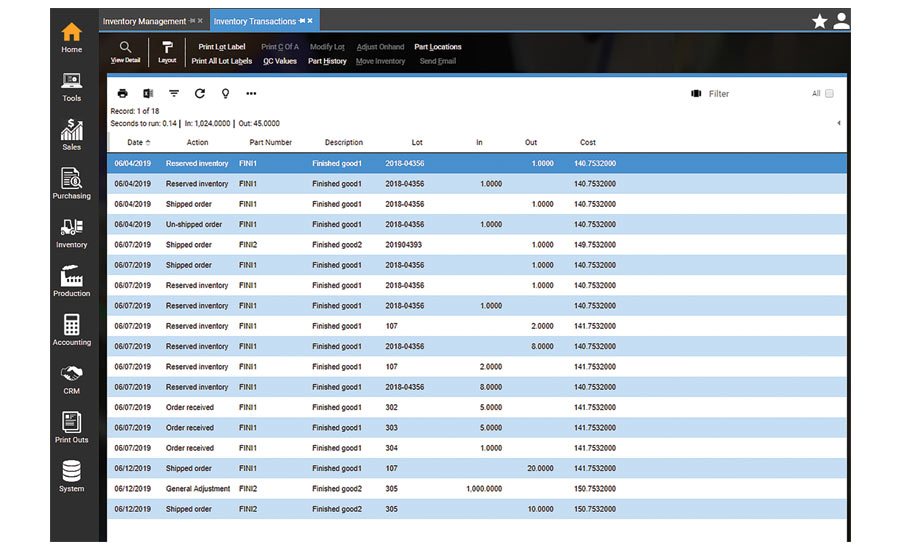Warehouse software builds a connected environment
Software improves order fulfillment, shipping and receiving








Software is a key component of warehouse management systems (WMS) that create today’s connected warehouse. It enables centralized management of tasks such as tracking inventory levels and stock locations, order fulfillment, and shipping and receiving. The latest software even reaches into the cloud to synchronize warehouse processes and help optimize performance.
Strength through connectivity
Building a connected warehouse requires linking customer relationship management (CRM), enterprise resource planning (ERP), third-party applications and the internet of things (IoT), according to Sudha Chandrasekharan, vice president of product management, HighJump, Minneapolis. “Connecting to ERP and CRM systems can facilitate planning, forecasting and real-time data analytics. In addition to enhancing warehouse and supply-chain performance, the connected warehouse generates information that can be analyzed for actionable analytics.”
OPM automated warehouse technology helps manufacturers pick cases and build pallets for delivery to grocery stores. Available from WITRON Integrated Logistics Corp., Arlington Heights, IL, the system analyzes the typical shipping rate of certain product groups. “The system affects deliveries to stores by calculating and building the perfect mixed pallet, which saves on transportation costs. The pallets are built according to each store’s planogram, which means that unloading and restocking of items in stores is optimized,” says Norman Leonhardt, director of business development.
The rise of new operating systems across Android, iOS and Windows 10 platforms for industrial mobile computing has created new opportunities. “You can now get a purpose-built device for almost any warehouse function with any type of operating system. However, you need smart software solutions to run on the mobile devices,” says Dustin Caudell, vice president of sales, RFgen Software, El Dorado Hills, CA.
Also, as technology evolves, it gets easier to connect machines directly to ERP systems. “Again, you need the right software to make that connection,” says Caudell.
Improved data management
WMS generate a lot of information within a warehouse. However, there are many systems, such as distributed order management (DOM), that give a bigger picture of what is going on in the fulfillment chain, according to Mark Dickinson, director of enterprise solutions, North America, SSI Schaefer Systems International Inc., Charlotte, NC.
“For customers who have multi-site operations, a DOM allows for real-time decisions on when and how order fulfillment should happen. If you have one branch that sees a higher-than-normal volume of orders, a DOM can automatically realign shipments for the day so the fulfillment of all customer orders are complete, and load balancing happens for all fulfillment points,” Dickinson explains.
For snack producers and bakeries, the right software can improve order fulfillment, shipping and receiving—from ingredients and packaging coming in, to finished products going out. “WMS can instill great operational processes for food manufacturers. However, without a seamless connection to an ERP solution, effectiveness is restricted,” according to Scott Deakins, COO, Deacom Inc., Chesterbrook, PA.
“To optimize control and management of the formulation-through-shipment process, WMS should speak to other areas of the business without interference. WMS and ERP perform best as a centralized unit without bridges or customizations that can cause a breakdown in communication. Electronic data interchange (EDI) and barcode serialization are two features of WMS that thrive in this type of environment,” Deakins says.
Warehouse efficiency begins with storage logistics. “In the food industry, we have parameters to consider other than speed—parameters such as allergens, temperature and expiration dates. WMS must be able to consider these attributes, plus the upcoming manufacturing schedule, in order to calculate the most-efficient put-away position for ingredients and packaged goods,” says Evan Garber, president, EVS LLC, Boulder, CO.
A multi-channel fulfillment manufacturer can save on labor costs by pulling items off the line that will be shipped before they are packaged, palletized and sent to stock. “Similarly, efficient WMS can tell a material handler to cross-dock a pallet from manufacturing to the shipping dock for an order. This eliminates the employee having to put away the pallet, then have it picked for an order soon after,” Garger adds.
Consumers are also demanding a larger variety of food items, which means that warehouses must handle a greater number of SKUs. Thus, snack producers and bakeries need to maximize the space that they have. To help achieve this goal, UNEX Manufacturing, Lakewood, NJ, offers SKUBE software, which analyzes an operation’s inventory and assigns products to the correct storage medium. It analyzes the movement of products so that items are assigned to the right pallets, carton flow or shelving units.
SKUBE software sorts through important factors, such as carton size, height and weight, as well as which products are in high demand, to determine what should go where in what type of carton flow setup. “This helps move the product through the order-picking process more efficiently. It provides an optimized model that reduces footsteps, decreases search and travel, and increases overall order picking productivity in the warehouse,” says Brian C. Neuwirth, president, UNEX Manufacturing.
The right software can improve lot tracking and traceability, which is especially important in light of the requirements put forth by the Food Safety Modernization Act. Food recalls are becoming more common—a trend that will likely continue as regulations tighten. Without the ability to track down contaminated food products and ingredients, food manufacturers and distributors risk losing revenue. Lot tracking and traceability software is the key to mitigating this risk.
Because of the FSMA, manufacturers are required to place a greater focus on how they prevent a recall, not just react to it. “We see this impacting the way in which businesses are leveraging the lot tracking functionality within their ERP solutions. They need to tighten lot tracking processes and improve QC reporting in order to deliver proper documentation to outline safety standards and preventative controls for the FDA,” Deakins says.
Ongoing developments
Wireless applications also are expanding inside the warehouse. “In general, food manufacturing happens in a rugged environment, which has posed a challenge for wireless technologies in the past,” says Garber. “Today, the ‘consumerization’ of enterprise technology allows warehouse personnel to use devices—such as smartphones—that are familiar and easy to learn, while being able to withstand harsh conditions.”
More tablets are being used for inventory counts, palletization and picking for shipments, according to Wayne Ortner, senior product advisor, FlexiBake, Vancouver, British Columbia. He notes that as technology has evolved to become more user-friendly, most manufacturers are opting for cloud-based software solutions over locally installed versions. “Unfortunately, we’ve seen a stumbling block when it comes to scanning lot numbers into inventory. Most major suppliers will supply product with lot numbers on their ingredient packages, but some are not yet barcoded lot numbers, meaning there is no way to scan lot codes into a system.”
Tools such as FlexiBake’s Direct Store Delivery (DSD) app, which is used by drivers to sync invoices and truck inventory while on the road, represent a big leap ahead for wireless applications, notes Ortner. With DSD apps, inventory can be controlled from delivery vehicles, as well as the warehouse.
Software is driving the latest picking solutions, as well. Chandrasekharan sees three main developments:
- Augmented reality picking with smart glasses is a fast, hands-free solution that improves productivity in warehouses. The operator wears the glasses, follows commands and scans product barcodes all within the glasses’ display, which merges with the warehouse environment.
- Voice technology, which also is hands-free, uses spoken commands for order fulfillment and improves picking accuracy, requires less training and is known to improve return on investment.
- Pick-to-light solutions offer an accurate, paperless way to pick items off warehouse shelves using light to direct workers. By using a combination of LED lights, letters and numbers, pick-to-light also improves productivity in warehouses.
Looking ahead to future advances in warehouse software, Caudell points to WMS-Lite, which directs worker activities through suggestion-oriented movement automation. “WMS-Lite provides warehouses with directed-movement capabilities for inbound processes, pick routing and replenishment without the hassle or cost of a large, complex system.”
More manufacturers are moving their warehouse software to cloud-based systems and apps such as FlexiBake, says Ortner. “By using a tablet, warehouse teams are able to confirm which lot codes need to be collected and stage the materials for the production department. Inventory is then updated across the board for all teams. Mobile inventory counts keep warehouse teams updated on the latest stock values and lot numbers.” The days of printing a pick list on a sheet of paper are quickly becoming a distant memory.
Looking for a reprint of this article?
From high-res PDFs to custom plaques, order your copy today!










